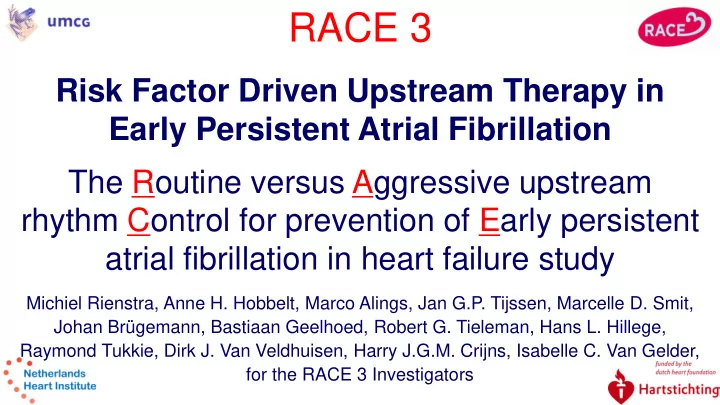

RACE 3 Risk Factor Driven Upstream Therapy in Early Persistent Atrial Fibrillation The Routine versus Aggressive upstream rhythm Control for prevention of Early persistent atrial fibrillation in heart failure study Michiel Rienstra, Anne H. Hobbelt, Marco Alings, Jan G.P. Tijssen, Marcelle D. Smit, Johan Brügemann, Bastiaan Geelhoed, Robert G. Tieleman, Hans L. Hillege, Raymond Tukkie, Dirk J. Van Veldhuisen, Harry J.G.M. Crijns, Isabelle C. Van Gelder, for the RACE 3 Investigators
Financial support of RACE 3 This work was supported by the Netherlands Heart Foundation (Grant 2008B035), and the Netherlands Heart Institute. Further, this trial was funded by unrestricted grants from AstraZeneca, Bayer, Biotronik, Boehringer-Ingelheim, Boston Scientific, Medtronic, Sanofi-Aventis, St-Jude-Medical paid to the Netherlands Heart Institute.
Background Maintenance of sinus rhythm improves AF-related symptoms However, sinus rhythm maintenance is cumbersome due to atrial remodelling, caused by risk factors and diseases underlying AF, and AF itself Recognition of the consequences of atrial remodelling has led to the notion that early intervening may prevent progression of AF Risk factor driven upstream therapy refers to interventions that aim to modify the atrial substrate, and at the same time has a favourable effect on risk factors and diseases underlying AF
Hypothesis and trial design Hypothesis: Risk factor driven upstream therapy is superior to conventional therapy for maintenance of sinus rhythm in patients with early persistent AF and HF RACE 3 trial design: Prospective, randomized, open label, superiority trial Investigator-initiated Multicenter: 14 sites in The Netherlands and 3 in United Kingdom Enrolment between 2009 and 2015 1 year follow-up
Flowchart Patients with early persistent AF and HF Causal treatment of AF and HF Risk factor driven upstream Conventional On top of that in the upstream group: 1. Mineralocorticoid receptor antagonists ECV after 3 weeks 2. Statins 3. ACE-inhibitors and/or angiotensin-receptor blockers In both groups rhythm control and 4. Cardiac rehabilitation: HF therapy according to guidelines - physical activity - dietary restrictions - counselling
Flowchart Patients with early persistent AF and HF Causal treatment of AF and HF Risk factor driven upstream Conventional On top of that in the upstream group: 1. Mineralocorticoid receptor antagonists ECV after 3 weeks 2. Statins 3. ACE-inhibitors and/or angiotensin-receptor blockers In both groups rhythm control and 4. Cardiac rehabilitation: HF therapy according to guidelines - physical activity - dietary restrictions 7-day Holter at 1-year - counselling
Primary endpoint Presence of sinus rhythm, defined as sinus rhythm during at least 6/7 th of assessable time, at the 7-day Holter* at 1-year *All 7-day Holters were analysed by central core lab blinded for randomised therapy
Patient characteristics Upstream Conventional n=119 n=126 64 ± 9 65 ± 9 Age (years) Male sex 79% 79% Total history of AF (months) 3 (2-7) 3 (2-5) Total persistent AF (months) 2 (1-4) 2 (1-4) Duration of HF (months) 2 (1-4) 2 (1-4) LVEF <45% 29% 29% NT-proBNP (pg/ml) 1057 (694-1636) 1039 (717-1755)
Primary endpoint Sinus rhythm at 1-year % of patients 75% 63% Upstream Conventional Odds ratio 1.765 Lower 95% confidence limit 1.115 Superiority hypothesis is proven p=0.021
Changes in secondary endpoints Upstream Conventional 20 baseline and 1-year % change between 10 0 -10 -20 * * * -30 -70 * RRsyst RRdiast NT-proBNP LVEF LA volume LDL BMI * P<0.05 upstream versus conventional group
Conclusion and implication The RACE 3 study shows that risk factor driven upstream therapy, including treatment of risk factors and change of lifestyle, is effective and feasible to improve maintenance of sinus rhythm in patients with early persistent AF and HF The effect of upstream therapy on reduction of risk factors, instead of its effect on atrial remodelling, is favourable RACE 3 may contribute to the shift to focus on risk factor modification to improve outcomes in AF patients
RACE 3 study organisation Trial and data management Steering committee W.J.M. Mol, O. Eriks I.C. Van Gelder H.J.G.M. Crijns M. Alings Central Holter core lab . M. Rienstra J. Haaksma . . J.G.P. Tijssen M.D. Smit Secondary end point adjudication committee J. Brügemann R.A. Tio, J.P. Van Melle R.G. Tieleman H.L. Hillege Statistical analysis committee R. Tukkie M. Rienstra, B. Geelhoed, H.L. Hillege, J.G.P. Tijssen, D.J. Van Veldhuisen I.C. Van Gelder Supported by: Data Safety and Monitoring Board Netherlands Heart Foundation H.J.J. Wellens, A.M. Wilde, Y.M. Pinto Netherlands Heart Institute
RACE 3 investigators The Netherlands: University Medical Center Groningen, Groningen - I.C. Van Gelder Amphia Hospital, Breda - M. Alings Martini Hospital, Groningen - R.G. Tieleman Admiraal De Ruyter Hospital, Goes - I. Aksoy . . Ziekenhuisgroep Twente Location Almelo, Almelo, - G.C.M. Linssen . Rijnstate Hospital, Arnhem - H.A. Bosker Spaarne Hospital, Haarlem - G.J.E. Verdel Radboud University Nijmegen Medical Center, Nijmegen - E. Cramer Maastricht University Medical Center, Maastricht - H.J.G.M. Crijns Tergooi Hospital, Blaricum - R.H.J. Peters Deventer Hospital, Deventer - Y.S. Tuininga Ommelander Hospital Group, Winschoten/Delfzijl, - A. Van Der Galiën/V. Hagens Onze Lieve Vrouwe Gasthuis, Amsterdam - G.S. De Ruiter United Kingdom: Birmingham City Hospital, Birmingham - G.Y.H. Lip Leeds General Infirmary, Leeds - M. Tayebjee Poole Hospital, Poole - C. Boos
Recommend
More recommend